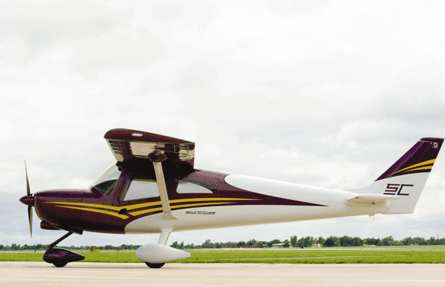Flight International has obtained the first pictures of a new larger tail for Cessna's Model 162 SkyCatcher, a change made after the loss of the prototype light sport aircraft last September during a power on spin.
SkyCatcher project engineer Neal Willford says Cessna developed a new tail after the crash with “increased area as well as a little less sweep”. To offset the added weight of the larger tail, the dorsal fin has been removed.
Willford says the new configuration was selected over several alternatives after Cessna was able to confirm, using data from the original wind tunnel test, that the new design “shows no unrecoverable spin conditions or characteristics”. The new tail (picture directly below) was installed on the SkyCatcher production aircraft late last year and lateral flight tests resumed in December. Willford says spin testing is expected to resume shortly.
 ©Cessna
©Cessna
Pictured below is the original tail design on the SkyCatcher
 ©Cessna
©Cessna
Cessna now expects the American Society of Testing and Materials (ASTM) compliance programme, which was originally scheduled to conclude by the end of 2008, to be completed by the end of the first half of 2009. But Willford says first delivery is still on track for second half of 2009 with 40 aircraft slated to be delivered by the end of this year.
To minimize the impact on the SkyCatcher production line in China, Willford says Cessna has built new tail and rudder parts for the initial batch of aircraft. China’s Shenyang Aircraft (SAC) is responsible for producing the SkyCatcher but Cessna didn’t want to require SAC to reproduce the parts which have been redesigned.
Willford says the subassemblies of the first aircraft are now coming together at SAC under the supervision of a small group of Cessna employees. The first SAC aircraft is scheduled to begin production flight tests in the second quarter.
After each SkyCatcher is completed in China, it will be disassembled and shipped to one of three US service centres which have been appointed to reassemble the aircraft. Once the aircraft are reassembled and flight tested they are distributed to customers through dealers.
Cessna has already secured over 1,000 orders, including 35% outside the US with half of these in Europe. Willford says Cessna is now working on a plan for assembling aircraft overseas as it prepares to begin deliveries to international customers in 2010.
Willford expects the new design to not have any impact on the SkyCatcher’s expected performance, which includes a cruise speed of 118kts and a 470nm range. As it is in the LSA category, the SkyCatcher will need to meet or exceed ASTM standards.
While the wind tunnel tests performed prior to the March 2008 first flight did not generate data highlighting potential problems with the original design, Willford says this is not unusual. “Wind tunnel data gives you a certain degree of confidence. It never is 100%. That’s why you flight test. It’s a risk reducer not a risk eliminator,” he says.
He adds after the accident Cessna went back to the company which did the data production following the wind tunnel test, Virginia-based Bihrle Research, to review the data. The original test, preformed at a vertical wind tunnel in Germany, did not include a power on stall but when power characteristics were added to the data Willford says Bihrle engineers “were able to duplicate what the pilot indicated he saw during the flight”. New configurations were subsequently entered into the equation until a new design was honed in on which Cessna is confident can withstand the spin tests to be re-performed in coming weeks.
Cessna was able to re-create the incident as the test pilot landed safety by parachute. But the prototype aircraft was destroyed, leaving only the production aircraft and the static test article among the three SkyCatchers initially built by Cessna’s experimental shop. Cessna has since outfitted the production aircraft, which initially was used for simpler flight tests and demonstrations at air shows, with instrumentation and a quick release door.
Source: FlightGlobal.com























